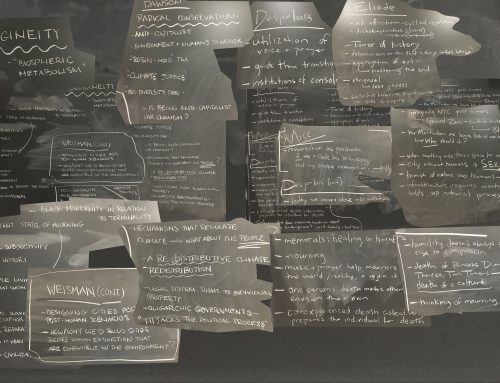It is perhaps tempting to think of death in universal terms, to present the experience of death as a singular experience shared by all living beings. Realities of deaths, however, and how deaths are experienced differently by various individuals and groups, indicate an intimacy and specificity that would seem to render the universal irrelevant. What seems worth getting at, is that even at the broadest level, certain tensions and contradictions immediately arise within death and how to think about it. Take, for instance, an exchange between Cecily Saunders of the hospice movement and an interviewer: in response to the question, “With the attitude you have, Dame Cecily, how do you face death yourself,” Saunders answered, “Well I don’t know that I have too much confidence in myself, but I have confidence in people round, and I believe that people […] will be waiting to help.” Despite having pioneered approaches to aiding others in their movement towards death, Sauders herself expects to feel no more prepared than any patient she might have encountered. It is always difficult to face death, even for those who face death every day.
Such a sentiment resonates with an op-ed written by Mary B. Mallison, registered nurse and editor of The American Journal of Nursing, in response to Derek Humphry’s Final Exit. “The popularity of Final Exit,” Mallison contends, “is largely a response to inadequate resources […] Too many dying people, however, will never experience the proper relief of symptoms or the passionate advocacy of hospice nurses. For them, assisted suicide is likely to grow as a bootlegged option, throwing its shadow of censure across a nation that is dangerously addicted to the quick fix and unwilling to bear the cost of compassion.” Mallison’s implication of an entire nation in the assisted suicides of individuals gestures towards a more nuanced understanding of death and mourning, that takes into account shared factors and experiences that inform every human death, stepping away from the universal towards the social. The suggestion that death is an economic experience, is of course not unique to “The Sorrow and the Pity of Final Exit.” In an essay, titled “Preventing Premature Deaths,” for the collection To Save Humanity: What Matters Most for a Healthy Future (Oxford University Press, 2015), Bill Clinton identifies a relationship between poverty and premature death, writing that “The burden of disease still falls heaviest on the poor” (81). If these statements seem unsurprising, it is perhaps because they imprecise in their criticisms. Ruth Gilmore’s definition of racism as “the state-sanctioned and/or extralegal production and exploitation of group-differentiated vulnerability to premature death,” more definitively demonstrates how experiences of death are never singularly individual nor wholly universal.
Perhaps to even attempt to understand an individual death it is best to understand it in context. As Claudia Rankine writes, “History’s authority over us is not broken by maintaining a silence about its continued effects.” The deaths of black men and women murdered by United States law enforcement officers cannot be understood outside or apart from experiences of slavery and anti-black racism. Death is contingent, it is relational. Different relations produce different deaths. As Orlando Patterson describes in Slavery and Social Death, “The condition of slavery did not absolve or erase the prospect of death […] The execution was suspended only as long as the slave acquiesced in his powerlessness […] Because the slave had no socially recognized existence outside of his master, he became a social nonperson” (5). Certainly the social death of slavery was not exactly what Cecily Saunders had in mind when pursuing her work in hospice care. The distinctions between Saunders’ and Patterson’s alternate usages and understandings of “death,” are perhaps useful however, if only demonstrate further tensions in the slippery subject that is the end of existence.

Recent Comments